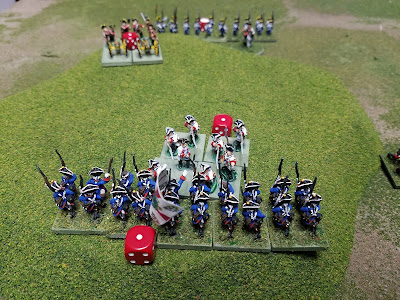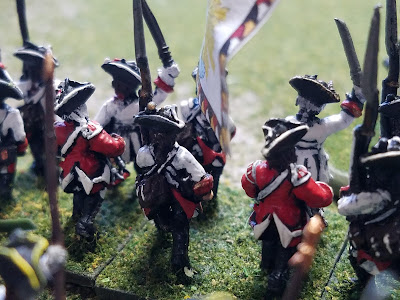As most of you who have been following this fun endeavor know, I have been playing the same battle with different sets of rules, and only utilizing 6 units from the Neil Thomas force builder in "One Hour Wargames." This entire thing was started by Norm with his excellent "pocket armies" idea and I have been capitalizing on his good ideas.
The scenario is #4 "Take the High Ground" from the One Hour Wargames scenarios. Austrians are the red player, Prussians are the blue in this Seven Years War showdown. Now to the action!
 |
| Prussians in battle line in foreground. Austrians both atop the hill and to the northeast of the hill. |
 |
| Initial Prussian moves towards the hill, leaving a good gap for the 2 batteries deployed to support the advance |
The first few turns pass in relative quiet with only the artillery offering battle. That will change soon!
 |
| Casualties scored on the Wolfenbuttel Regiment on the left as it approaches the guns. |
 |
| Lights moving through the woods. Check! |
Another neat feature about these rules are the way firing and melee are handled practically the same. While there are numerous modifiers, they aren't too bad and the game doesn't feel like an accounting drill like some others.
So far, 4 turns into the game, they've played according to my historical pre-conceived notions. Like marching a regiment up into the face of canister fire means the regiment is going to get hosed with grapeshot and forced back.
 |
| Your army commander automatically removes hits, provided all of the prerequisites have been met. |
 |
| I'm using my Prussian cavalry to screen for me. Note the 2 Prussian units at the base of the hill. Their shooting will prove to be abysmal! Even with the modifier! My rolling is just that bad. |
 |
| Prussians looking okay now but still not causing any casualties. |
 |
| Prussian attack falling apart! |
 |
| All 3 Prussian units suffering hits and/or in a state of reforming. |
 |
| Austrians. Now you see them. |
 |
| Now you don't! |
 |
| The Austrians send a Hungarian unit to the hill to hold it. Meanwhile, the Prussians continue to rally |
 |
| reformed Prussian assault! |
I move my cavalry up to charge the lights, while Hulsen prepares to assault the hill!
 |
| CHARGE! |
 |
| Hulsen is victorious but the Dragoons are sent packing! Both combats took at least 2 rounds to finish. |
My units are in a precarious position and all close to breaking again. Meanwhile the Austrians have rallied the guns and are back on the hill with a light battalion and a medium artillery battery. I'm not even close to breakpoint for either side yet however I'm 4 turns from turn 15 (OHW scenario 4 victory conditions stipulate 15 turns). This was a clear Austrian victory. Again!
Thoughts?
Here is what I liked about Honours of War:
All of the fighting is adjudicated through the same table. This is a very clean way to do it and it moves the game along quickly.
I liked the subtle command rules, until I had units falling back everywhere and could no longer control them. This would be handy in big battles with scores of units, but doesn't work great for the whole pocket armies idea.
The capabilities of the units are perfect and the battle has a great SYW feel to it. You have to think like a commander on a horse and musket battlefield. (I honestly can't think of a bigger compliment than this, by the way).
This is very much a general's game where planning out your battle pays off. In that sense, it really captures the feel of the SYW in an efficient and elegant way.
As Jonathan says, I can use my singly based unit stands here and it will not really matter too much.
Here is what I disliked about Honours of War:
Are the standard light infantry too powerful? I played a test game before the test game and I may have been doing something incorrectly because my lights were kicking a** and taking names and shooting like their line infantry cousins. This seemed like it wasn't correct, and given Mr Flint's obvious knowledge of the period, I feel like I was doing something wrong. In my game here, the light battalion threw off the dragoons in melee! This guys are super soldiers!
The strengths of the rules seem to be in bigger battles - meaning a smaller game with a few units per side probably won't play as enjoyable as if you had 20 battalions on a side. I hope that makes sense.
So there you have it. My final batrep from this solo, SYW trio of experiments! I saved the best for last and this was a very enjoyable battle. I would like to play a bigger game of Honours of War with even more units, perhaps even an historical scenario if I can get more units painted. I'm glad to have finally played these rules as I've been wanting to for quite some time.










Excellent! I am glad you finally got HoW onto your table and that the experience was a positive one. The game plays smoothly even with large battles. It did not take you long to figure out that the key is pulling damaged units out of line to recover while a second line carries on the work. Having a second line is important!
ReplyDeleteAs for your supermen light infantry, STANDARD light infantry fight at the same effectiveness as INFERIOR Infantry and SUPERIOR light infantry fight at the same effectiveness as STANDARD infantry. They should pose superhuman resistance and they often would be classed as SMALL units. Also note that cavalry should NEVER attack undamaged infantry frontally.
There are lots of subtleties in the rules and it always gives a good game. My favorite for the period in 15mm.
If you ever make it out to the Pacific Northwest and want to participate in a BIG game, let me know.
Thank you, Jonathan. Im not sure how i approached the game in terms of expectations of my light infantry's performance except that ive played many Napoleonic games the past 2 years and barely any 18th century games and perhaps my expectations were or should have been different? Perhaps i looked at them more of skirmishers, rather than a dispersed infantry battalion. (I should know better).
DeleteWow an opportunity to game in one of your SYW games? Where do i sign up, sir?? :) makes me want to volunteer for travel at work this year ;)
I did note that had there been a second line to carry on, the Prussians could have pressed the attack and taken the hill before the arrival of the Austrians.
A great game and im looking forward to playing more.
One important correction to my reply above. The sentence should read, "They should NOT pose superhuman resistance..." Small, open order light infantry are not well suited to standing up against opponents in open terrain.
DeleteIf you ever plan to be in the neighborhood of the upper left corner of the US, let me know.
I figured that's what you meant! Absolutely, if i am out your way i will certainly let you know. We have an office in Bothell. I dont know if that's close to you, but it at least take me out there to "the upper left hand corner" of the country.
DeleteThe same holds true for you, as well. If you find yourself in the mid atlantic, let me know. Always happy to out a friendly game on!
Spokane is on the east side of the state about 300 miles from Seattle. Still, if you make it to Bothell, Spokane is only an hour flight by air.
DeleteMid-Atlantic? Where are you exactly? I have a son in DC that we visit occasionally.
We live in Southeastern Pennsylvania, suburbs of Philadelphia. It's a 2 hour drive from DC.
DeleteI am in DC alot as our HQs is there. Surprisi gly a good bit of gaming goes on in DC and northern Virginia!
Very interesting replay and also an interesting series of three games. Glad to see that an overall favourite came out from the test games. I am fortunate by chance to have all three of the tested rule sets and have already started to browse the Rank and File after your last post.
ReplyDeleteThe fragility of playing with 6 units does bring some problems with 'brigade' orientated rules. I have a small Black Powder game on the table at the moment and I have (again) had to drop the rule that has the combined effect of shaken and lost units breaking the brigade, because a 1 brigade game is too easily made hostage to it. I have replaced it with 3 absolute losses will end the game.
I suppose in that respect the bluntness of the Neil Thomas OHW rules can be better appreciated as a design decision.
Anyway, great stuff and a very interesting start to the 2020 schedule.
Norm,
DeleteYes i realized that more as a result of playing than planning. Some games require a little tweaking for a smaller number of units. Glad you liked my little mashup. I plan on doing more of these smaller, more manageable game series this year. At the very least, im pushing toy soldiers around and blogging about it, and that's never a bad thing!
Having six BMUs only is a small game, indeed. It made for an interesting and fun game. With such few units, luck can play a larger role than in a larger game. Twelve BMUs per side would be even more interesting.
DeleteJonathan, i think having 12 units would have made the game "higher octane" with alot more fighting. Once the Prussian line broke they headed to the rear and took 3 turns to reform.
DeleteWhat a fantastic period! Beautiful uniforms and units all around, nice post!
ReplyDeleteThank you, Phil!
DeleteIf the game was enjoyable, that to my mind, bespeaks any problems at half solved already. As far as 'pocket armies' are concerned, why should the whole 6 units form a single Brigade - or, if it does, why are subdivisions into 'wings' and/or a centre not possible? Perhaps one has to go outside the 1HW game set, but something of the sort might be worth a try.
ReplyDeleteThe scenario, by the way, looks rather like one of C.S. Grant's scenarios: 'Reinforcements in defence.' I've played that scenario at least 4 times: Ancients (Romans), Napoleonic, ACW and, somewhat inadvertently(!) WW2!
Cheers, Archduke. The OHW force structures are not explained as to what they represent. In this game, the Prussians were battalions, and so the infantry of both sides were supposed to be brigades, with the artillery, cavalry, and lights serving as independent units, so the forces in each side were an infantry brigade, and supporting independent units. I should have specified that
DeleteI do believe Mr Thomas planned his scenarios in the manner of "tabletop teasers" and all 30 were inspired by classic wargames scenarios over the last 40 years.
Really look like a good set of rules - apart from the 'super lights'.
ReplyDeleteThe activation system sounds quite subtle.
Cheers, Darren. It's a good set of rules. Solidly based on historical precedent, IMHO, i like the activation system as it builds in a bit if uncertainty, but not as dramatic as "slack chowder".
Delete